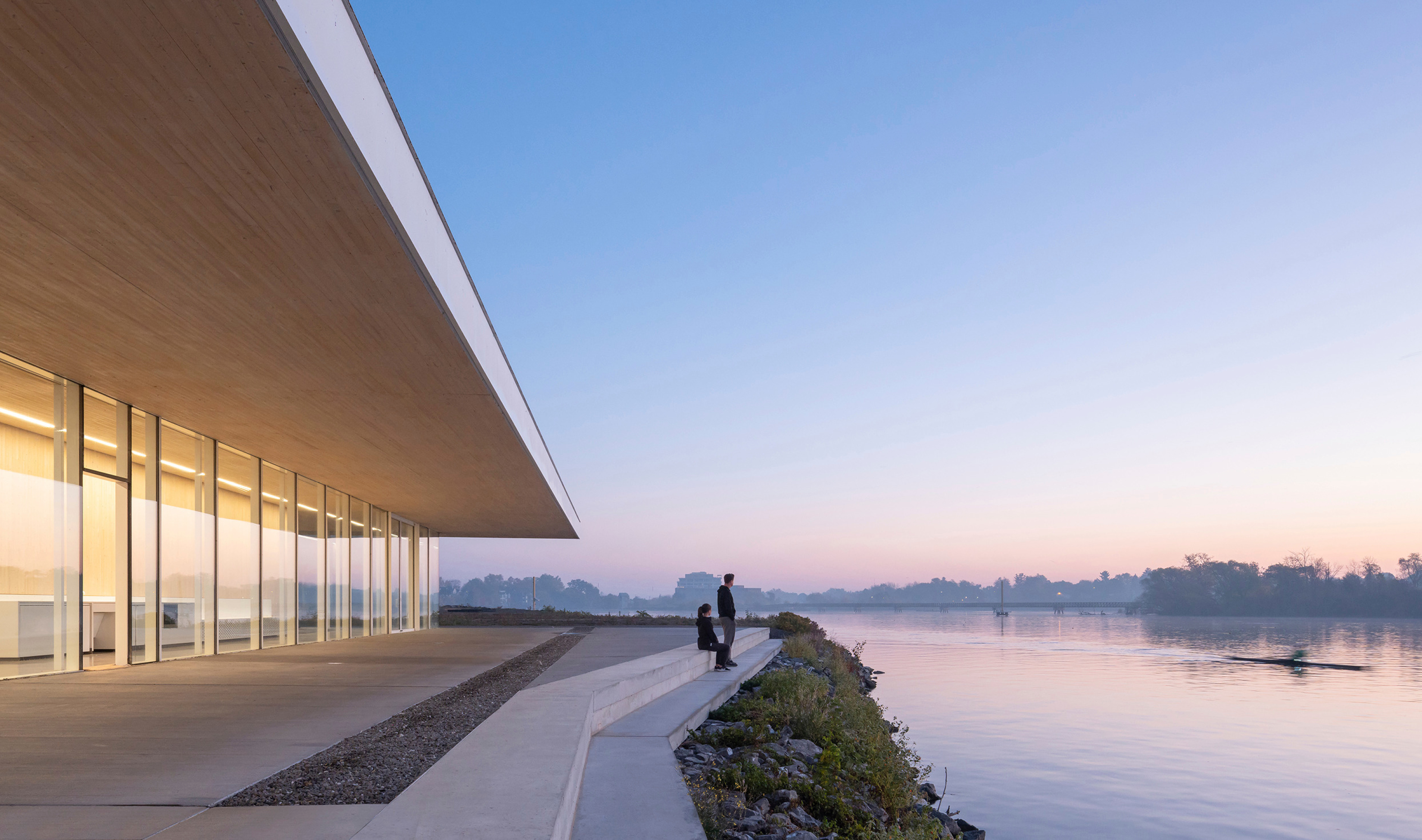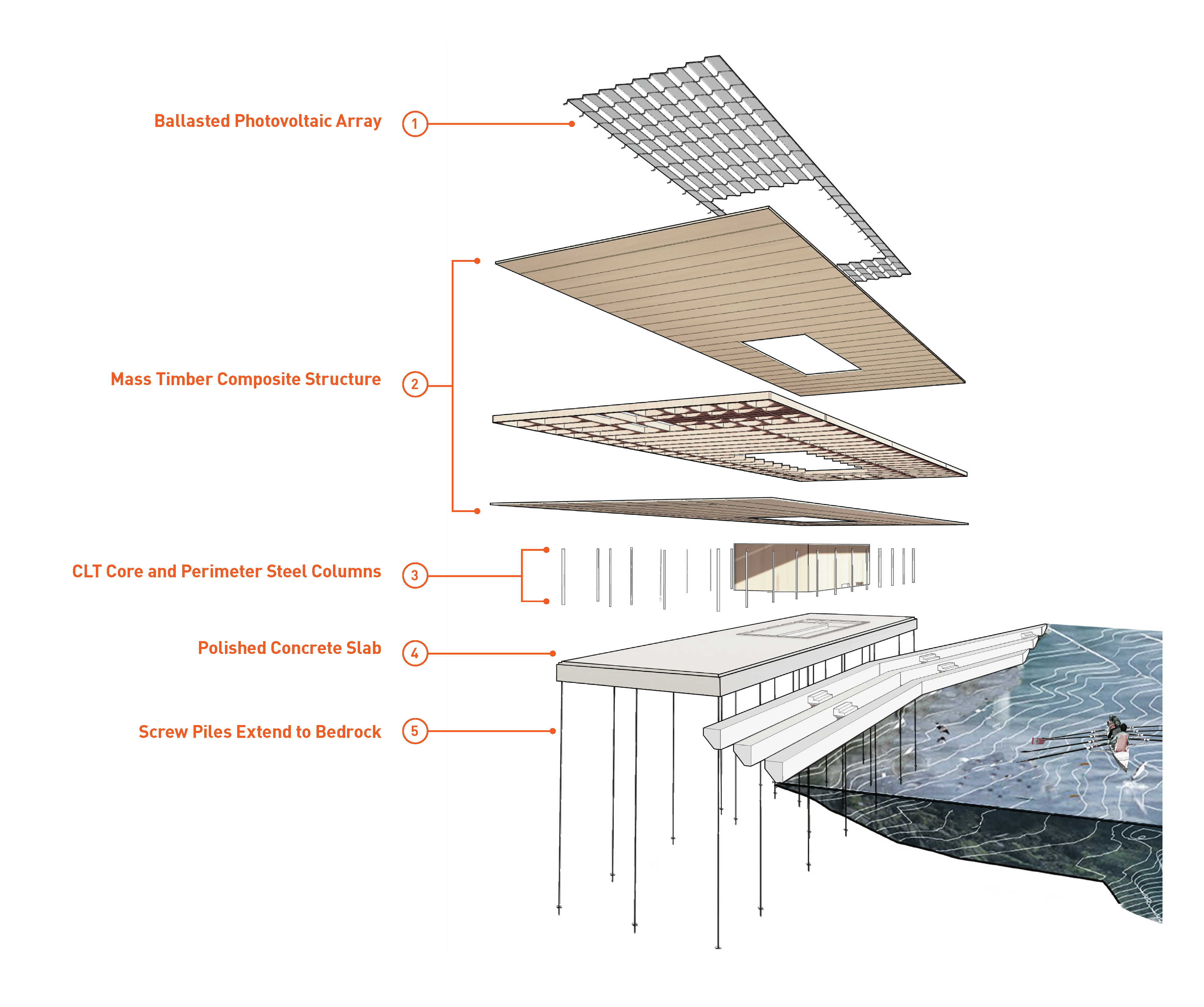Location: St. Catharines, Ontario
Completed: 2022
Architect: MacLennan Jaunkalns Miller Architects Ltd. (MJMA)
Nominated by: Jennie Stevens, MPP (St. Catharines)
Set quietly on Henley Island in St. Catharines, the Neil Campbell Rowing Centre is both modest and unmistakable. Designed as a home for Canada’s most storied regatta, it balances deep community roots with striking architectural clarity. For athletes, families, and spectators, it offers a simple yet commanding backdrop to a century-old ritual—earning a Governor General’s Medal in Architecture for its bold simplicity and respectful siting.
A Legacy on the Water
Henley Island has hosted the Royal Canadian Henley Regatta since 1903, along with Olympic trials, the Pan-Am Games, and World Championships. Every summer, the island comes alive with rowers, parents, coaches, and volunteers. A perfect confluence of geography, calm waters, and shelter from the wind made the island an ideal location for this sport, transforming the pond into a place of discipline, celebration, and deep community memory.
While a number of buildings have been previously built on the island, none quite reflected the stature of Henley Island as a world-class rowing destination. The Neil Campbell Rowing Centre—named for the late Olympian and local hero—was commissioned as part of the 2022 Canada Summer Games. Modest in size but ambitious in spirit, it became the first purpose-built facility on the site, and a new anchor for life on the island.
Responding to Ritual
For MJMA, the work began with conversations with the project’s champions: the rowing community, and more specifically, the parents. Many had rowed at Henley themselves and now watched their children compete. They knew where the building needed to go, how people moved, and where the best vantage points were.
Those early conversations shaped the project’s most distinctive and iconic features. The bold, oversized roof—both structurally expressive and symbolically generous—offers shelter from sun and rain while framing long views of the racecourse. Below it, four-metre-wide sliding glass doors open fully during events, transforming the building into a pavilion: a place of gathering, cheering, and refuge. A stepped edge along the pond invites people to sit, watch, and dip their feet—an idea sparked when the design team noticed children clambering over brush just to touch the water.

New concrete steps connect the rowing centre to the water. Image by Scott Norsworthy, courtesy of MJMA.
Quietly Sustainable
Though not required by the client, the building meets Canada’s most rigorous national benchmark for net-zero operations: Canada Green Building Council’s (CAGBC) Zero Carbon Building standard. Achieving this standard means that over the course of a year, the centre will effectively emit zero carbon from its building operations, achieved through a combination of efficient design, low-carbon systems, and on-site renewable generation.
The building’s largest gesture—its roof—played an important role in achieving high levels of performance, despite the fact that achieving net zero was not initially a goal. It brought the design team close enough that they decided to push further, integrating a low-carbon steel and Canadian mass timber structure topped with a high-performance roof and 43 kW solar array. Triple-glazed curtain walls reduce heat loss while bringing in ample daylight, with deep roof overhangs creating shade during the hottest hours of the day. A public energy monitor shows real-time consumption, inviting users to see the building as a partner in performance.

Diagram showing major components, including many mass timber elements and a rooftop solar panel array. Image courtesy of MJMA.
A Building That Knows Its Place
The power of the Neil Campbell Rowing Centre lies in its restraint. Every element of its design is carefully considered. The Neil Campbell Rowing Centre proves that simplicity can be striking, and that great architecture doesn’t always need to shout.
But what makes the Neil Campbell Rowing Centre truly remarkable is how closely it listens to the rituals of rowing, the rhythms of the regatta, and the natural cycles of the island. The architects played a powerful role as translator, turning conversations into a distinct form that embodies both a response to the community’s needs and a desire to be light on the land. The result is a building that doesn’t just serve a community, but also reflects it—one roofline, one step, one opening at a time.
This post is part of the OAA’s Queen’s Park Picks 2025 series, where Ontario’s Members of Provincial Parliament (MPPs) were encouraged to nominate a building in their riding for a chance to learn more about it. This year, MPPs were asked to consider various typologies related to “reshaping communities” when making their suggestion, tying into the 2025 OAA Conference theme. Check out the rest of the series to learn more about great buildings across the province.